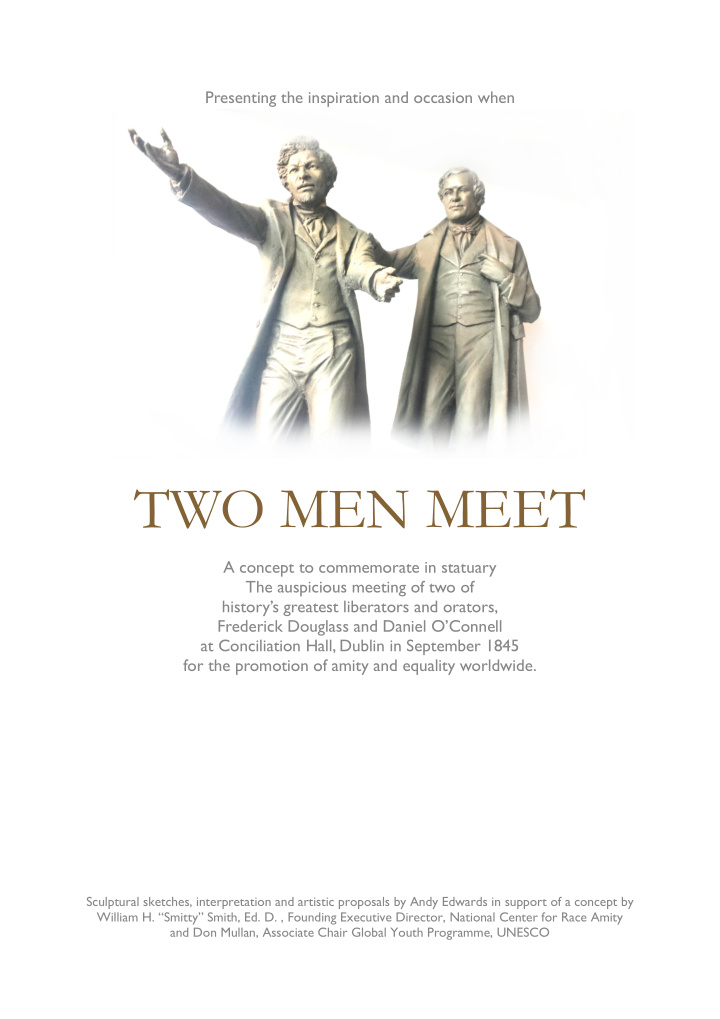



Presenting the inspiration and occasion when TWO MEN MEET A concept to commemorate in statuary The auspicious meeting of two of history’s greatest liberators and orators, Frederick Douglass and Daniel O’Connell at Conciliation Hall, Dublin in September 1845 for the promotion of amity and equality worldwide. Sculptural sketches, interpretation and artistic proposals by Andy Edwards in support of a concept by William H. “Smitty” Smith, Ed. D. , Founding Executive Director, National Center for Race Amity and Don Mullan, Associate Chair Global Youth Programme, UNESCO
As heard by Frederick Douglass from the speech made by his hero Daniel O’Connell at a repeal meeting in Conciliation Hall, Dublin, Monday September 25th 1845
From a letter to William Lloyd Garrison written by Douglass in Scotland just after his five months in Ireland, The letter was published in The Liberator, October 24th 1845
The intimacy of this monument is unique. It intends to render life, warmth and movement and transmit these forces through sensitive expression. The power is in the space between: the consideration between words; the moment before an embrace; the distance that was between now reduced to a gap easily filled by the viewer’s own will.
Thought Emotion Action The composition is a generative circuit entering the material plane through eye contact. The energy path flows up- wardly through the body to the heart where thoughts become processed into feelings. An emotional charge is passed through the cradle of the shoulders and becomes action through the outstretched hand, leaving as the spirit of pure will with which anything can be built. The great intent of this work is to transfer this into the viewer. A refined sculpture by progressing scale models to perfect a harmonious design can hold a person in aesthetic arrest for long enough to create a resonance that by its beauty reminds us that we are all held together by the same vast and powerful force. If I have seen further, it is by standing on the shoulders of giants” The idea in this line popularized in a letter from Isaac Newton to Robert Hooke, becomes, through the narrative of this meeting of these great men and great belief, updated towards where we are moving today as a consciousness out of the merely individual. : “Through sharing our vision and with a reassuring hand on each other’s shoulder, we go even beyond where the heart dares to see.”
Dublin and Boston, sites of Inspirational Oratory Faneuil Hall and Conciliation Hall share not only an architecture but a heritage as stages for great oratories. They both became the footstools for the desire and movements for independence and freedom.
Coming Home The meeting between Frederick Douglass and Daniel O’Connell at Conciliation Hall in 1845 is transferred in not only time but geography with references to the Dublin site in the ges- ture of the figures and pattern of the paving and possible proximity to Faneuil Hall. Point of View The base on which the two men stand with the globe between them and compass points to the four corners represents the international moral impact of their meet- ing to all of humanity. “I prayed for freedom for twenty years, but received no answer until I prayed with my legs.” - a quote attributed to Frederick Douglass, possibly originally appearing in ‘The North Star’
Influence and Expansion It maybe worth appending excerpts from the 1916 proclamation of the Irish Republic as so many of its fundamentals espoused were ideals of Daniel & Frederick and their noted and recorded influence on each other, “We declare the right of the people to the ownership of our* land, and to the unfet- tered control of our destinies, to be sovereign and indefeasible. The long usurpation of that right by a foreign people and government has not extinguished the right, nor can it ever be extinguished except by the destruction of the people. Standing on that fundamental right and again asserting it in arms in the face of the world, we hereby proclaim our Republic as a Sovereign Independent State. And we pledge our lives and the lives of our comrades-in-arms to the cause of its freedom, of its welfare, and of its exaltation among the nations. The Republic is entitled to, and hereby claims, the allegiance of every man and woman. The Republic guarantees religious and civil liberty, equal rights and equal op- portunities of all its citizens, and declares its resolve to pursue the happiness and prosperity of the whole nation and of all its parts, cherishing all the children of the nation equally, and oblivious of the differences carefully fostered by an alien govern- ment, which have divided a minority in the past. We place the cause of the Republic under the protection of the Most High God, Whose blessing we invoke and pray that no one who serves that cause will dishon- our it by cowardice, inhumanity, or rapine. In this supreme hour our nation must, by its valour and discipline and by the readiness of its children to sacrifice themselves for the common good, prove itself worthy of the august destiny to which it is called.” Though self evident, sovereign and indefeasible as is written, these ideals were as cer- tainly stirred by the charters of O'Connell and Douglass as were many others throughout the international community. It is therefore vitally important that any process to finalise and evolve this monument concept as put forward makes particu- lar attachment to rights for all people by the integration of symbols, links and an ex- tending and expanding narrative by invitational process. “When I ran away from slavery, it was for myself; when I advocated emancipation, it was for my people; but when I stood up for the rights of women, self was out of the question,”
Recommend
More recommend